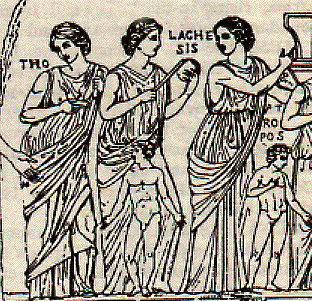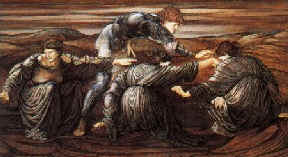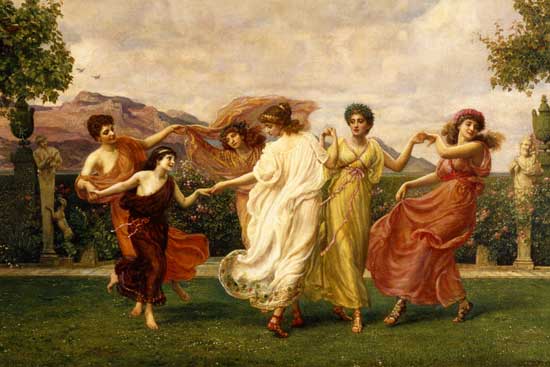***The Fates, Gray Sisters, Enforcers, & Horae***
- The Fates
 - The Fates, also called the Moirai or the Parcae, determined when life begins, when it ends, and what happens in between. They were made up of three women:
- Clotho, who appeared as a maiden and spun the thread of life. Her name meant The Spinner
- Lachesis, who appeared as a matron and measured the thread of life. She was the Caster of lots
- Atropos, who cut the thread of life, and appeared as a crone. Her name meant, Unbending Though the smallest of the three, she is the most terrible.
They were the daughters of Erebus (Darkness) and Nyx (or of Zeus and Themis). Some say that Zeus could intervene in their decisions and that they could be manipulated, but in most myths they were eternal and more powerful than any of the Gods. Another story says they are the parthenogenic daughters of Ananke. In Delphi, they only worshipped Clotho and Atropos.
- The Graiai
 - The Graiai, or the the three Gray Sisters, were beautiful. They were described as "fair-faced and swan-like" but they's had gray hair from the day they were born and they shared one eye and one tooth, but they lost even that when Perseus stole their eye and later threw it in a lake. Despite being so easily taken advantage of, they were very wise. Their names were:
- Deino or Dread (or Terrible)
- Enyo or Horror (or War-like)
- Pemphredo or Alarm (or Wasp)
They were probably goddesses worshipped by the swan cults (swans were not just a symbol of beauty, but also of cunning and other darker meanings).
- The Keres
- The Keres are also called the Dogs of Hades. They are associated with the Harpies and the Erinyes, and they are terrifying creatures. They are sharp clawed creatures who dress in red and drink the blood of their victims. They carry out the Fates' commands, insofar as they are in many ways the personification of the inevitability of death, and are often seen hovering around battle fields. They were daughters of Nyx, just like the Fates, and it can be a little unclear where their work ended and the work of the Erinnyes (see below) began.
- The Erinnyes
 - The Erinnyes (in English, the Furies) were some seriously fearsome creatures. They were conceived when Uranus' spilled blood hit Gaia's body, and were therefore older than any of the Olympian Gods. "These Erinnyes are crones with snakes for hair, dogs' heads, coal-black bodies, bats' wings, and bloodshot eyes. In their hands they carry brass-studded scourges and their victims die in torment." It isn't a great idea to mention their names in conversation, so instead you should call them the Eumenides, or the Kindly Ones. There are three:
- Tisiphone, the Avenger
- Megara, the Jealous
- Alecto, the Unresting
Their purpose was to torment sinners, which they did on Earth as well is in Tartarus. The sight of one could cause insanity, and they often drove offenders to suicide. Originally they punished only offenders of patricide, matricide, or breakers of oaths, but after a while they punished any sins. They lived in Erebus (Darkness) but traveled the Earth constantly in search of transgressors. The Furies get special press in the play the Eumenides from the Oresteia of Aeschylus. Sadly, the thing ends with the loss of a lot of their power. The picture there portrays the Furies berating Orestes (in that very play) as painted by William Adolphe Bouguereau.
- The Horae
 - They were the goddesses orderly things like Seasons, and because of their orderly aspect eventually became goddesses of justice. They measured out the weather as it seemed appropriate and guarded Olympus from any overambitious mortals. They had a few cameos in the Big Myths: the Hora of Spring went with Persephone when she went down with Hades every year, and some of the Horae helped dress Aphrodite as she emerged from the ocean. They got different names (and numbers) from different authors, but I like Hesiod's breakdown:
- Eunomia, Good Custom
- Dike, Justice
- Eirene, Peace
Homer actually tended to keep them strictly with the seasons, and they only worshipped two in Athens, but Hyginus lists at least 21 Horae (including Horae of the Hours)! Generally they were happy little goddesses. Lots of cavorting, much like the Muses and the Graces (Charites) who they liked to hang out with when they weren't doing their day job of keeping track of orderly customs and justice.
Homepage |
Major Goddesses |
Minor Goddesses |
Humans |
Nymphs |
Monstresses & Monstrosities |
The Myths Pages |
Amazons |
Men |
Terms |
Gallery |
Dreambook |
References & Links
Contact me at ailiathena@yahoo.com
Last Updated March 18, 2005
|